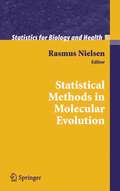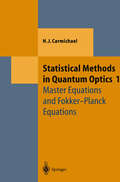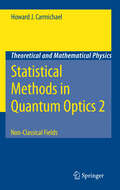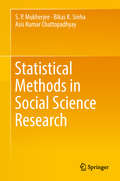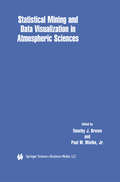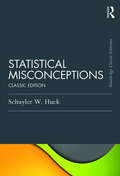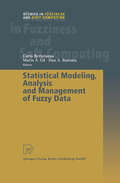- Table View
- List View
Statistical Methods in Medical Research
by Charan Singh RayatThis book covers all aspects of statistical methods in detail with applications. It presents solutions to the needs of post-graduate medical students, doctors and basic medical scientists for statistical evaluation of data. In present era, dependency on softwares for statistical analysis is eroding the basic understanding of the statistical methods and their applications. As a result, there are very few basic medical scientists capable of analyzing their research data due to lack of knowledge and ability. This book has been written in systematic way supported by figures and tables for basic understanding of various terms, definitions, formulae and applications of statistical methods with solved examples and graphic presentation of data to create interest in this mathematical science.
Statistical Methods in Molecular Biology (Methods in Molecular Biology #620)
by Heejung Bang, Xi Kathy Zhou, Heather L. Epps and Madhu MazumdarStatistical Methods in Molecular Evolution (Statistics for Biology and Health)
by Rasmus NielsenIn the field of molecular evolution, inferences about past evolutionary events are made using molecular data from currently living species. With the availability of genomic data from multiple related species, molecular evolution has become one of the most active and fastest growing fields of study in genomics and bioinformatics. Most studies in molecular evolution rely heavily on statistical procedures based on stochastic process modelling and advanced computational methods including high-dimensional numerical optimization and Markov Chain Monte Carlo. This book provides an overview of the statistical theory and methods used in studies of molecular evolution. It includes an introductory section suitable for readers that are new to the field, a section discussing practical methods for data analysis, and more specialized sections discussing specific models and addressing statistical issues relating to estimation and model choice. The chapters are written by the leaders of field and they will take the reader from basic introductory material to the state-of-the-art statistical methods. This book is suitable for statisticians seeking to learn more about applications in molecular evolution and molecular evolutionary biologists with an interest in learning more about the theory behind the statistical methods applied in the field. The chapters of the book assume no advanced mathematical skills beyond basic calculus, although familiarity with basic probability theory will help the reader. Most relevant statistical concepts are introduced in the book in the context of their application in molecular evolution, and the book should be accessible for most biology graduate students with an interest in quantitative methods and theory. Rasmus Nielsen received his Ph.D. form the University of California at Berkeley in 1998 and after a postdoc at Harvard University, he assumed a faculty position in Statistical Genomics at Cornell University. He is currently an Ole Rømer Fellow at the University of Copenhagen and holds a Sloan Research Fellowship. His is an associate editor of the Journal of Molecular Evolution and has published more than fifty original papers in peer-reviewed journals on the topic of this book. From the reviews: "...Overall this is a very useful book in an area of increasing importance." Journal of the Royal Statistical Society "I find Statistical Methods in Molecular Evolution very interesting and useful. It delves into problems that were considered very difficult just several years ago...the book is likely to stimulate the interest of statisticians that are unaware of this exciting field of applications. It is my hope that it will also help the 'wet lab' molecular evolutionist to better understand mathematical and statistical methods." Marek Kimmel for the Journal of the American Statistical Association, September 2006 "Who should read this book? We suggest that anyone who deals with molecular data (who does not?) and anyone who asks evolutionary questions (who should not?) ought to consult the relevant chapters in this book." Dan Graur and Dror Berel for Biometrics, September 2006 "Coalescence theory facilitates the merger of population genetics theory with phylogenetic approaches, but still, there are mostly two camps: phylogeneticists and population geneticists. Only a few people are moving freely between them. Rasmus Nielsen is certainly one of these researchers, and his work so far has merged many population genetic and phylogenetic aspects of biological research under the umbrella of molecular evolution. Although Nielsen did not contribute a chapter to his book, his work permeates all its chapters. This book gives an overview of his interests and current achievements in molecular evolution. In short, this book should be on your bookshelf." Peter Beerli for Evolution, 60(2), 2006
Statistical Methods in Psychiatry and Related Fields: Longitudinal, Clustered, and Other Repeated Measures Data (Chapman & Hall/CRC Interdisciplinary Statistics)
by Ralitza GueorguievaData collected in psychiatry and related fields are complex because outcomes are rarely directly observed, there are multiple correlated repeated measures within individuals, there is natural heterogeneity in treatment responses and in other characteristics in the populations. Simple statistical methods do not work well with such data. More advanced statistical methods capture the data complexity better, but are difficult to apply appropriately and correctly by investigators who do not have advanced training in statistics. This book presents, at a non-technical level, several approaches for the analysis of correlated data: mixed models for continuous and categorical outcomes, nonparametric methods for repeated measures and growth mixture models for heterogeneous trajectories over time. Separate chapters are devoted to techniques for multiple comparison correction, analysis in the presence of missing data, adjustment for covariates, assessment of mediator and moderator effects, study design and sample size considerations. The focus is on the assumptions of each method, applicability and interpretation rather than on technical details. Features Provides an overview of intermediate to advanced statistical methods applied to psychiatry. Takes a non-technical approach with mathematical details kept to a minimum. Includes lots of detailed examples from published studies in psychiatry and related fields. Software programs, data sets and output are available on a supplementary website. The intended audience are applied researchers with minimal knowledge of statistics, although the book could also benefit collaborating statisticians. The book, together with the online materials, is a valuable resource aimed at promoting the use of appropriate statistical methods for the analysis of repeated measures data. Ralitza Gueorguieva is a Senior Research Scientist at the Department of Biostatistics, Yale School of Public Health. She has more than 20 years experience in statistical methodology development and collaborations with psychiatrists and other researchers, and is the author of over 130 peer-reviewed publications.
Statistical Methods in Psychiatry and Related Fields: Longitudinal, Clustered, and Other Repeated Measures Data (Chapman & Hall/CRC Interdisciplinary Statistics)
by Ralitza GueorguievaData collected in psychiatry and related fields are complex because outcomes are rarely directly observed, there are multiple correlated repeated measures within individuals, there is natural heterogeneity in treatment responses and in other characteristics in the populations. Simple statistical methods do not work well with such data. More advanced statistical methods capture the data complexity better, but are difficult to apply appropriately and correctly by investigators who do not have advanced training in statistics. This book presents, at a non-technical level, several approaches for the analysis of correlated data: mixed models for continuous and categorical outcomes, nonparametric methods for repeated measures and growth mixture models for heterogeneous trajectories over time. Separate chapters are devoted to techniques for multiple comparison correction, analysis in the presence of missing data, adjustment for covariates, assessment of mediator and moderator effects, study design and sample size considerations. The focus is on the assumptions of each method, applicability and interpretation rather than on technical details. Features Provides an overview of intermediate to advanced statistical methods applied to psychiatry. Takes a non-technical approach with mathematical details kept to a minimum. Includes lots of detailed examples from published studies in psychiatry and related fields. Software programs, data sets and output are available on a supplementary website. The intended audience are applied researchers with minimal knowledge of statistics, although the book could also benefit collaborating statisticians. The book, together with the online materials, is a valuable resource aimed at promoting the use of appropriate statistical methods for the analysis of repeated measures data. Ralitza Gueorguieva is a Senior Research Scientist at the Department of Biostatistics, Yale School of Public Health. She has more than 20 years experience in statistical methodology development and collaborations with psychiatrists and other researchers, and is the author of over 130 peer-reviewed publications.
Statistical Methods in Psychiatry Research and SPSS
by M. Venkataswamy ReddyThis volume, Statistical Methods in Psychiatry Research and SPSS, now going into its second edition, has been helping psychiatrists expand their knowledge of statistical methods and fills the gaps in their applications as well as introduces data analysis software. It addresses the statistical needs of physicians and presents a simplified approach. The book emphasizes the classification of fundamental statistical methods in psychiatry research that are precise and simple. Professionals in the field of mental health and allied subjects without any mathematical background will easily understand all the relevant statistical methods and carry out the analysis and interpret the results in their respective field without consulting any statistician. This new volume has over 100 pages of new material, including several new appendixes. The sequence of the chapters, the sections within the chapters, the subsections within the sections, and the points within the subsections have all been arranged to help professionals in classification refine their knowledge in statistical methods and fills the gaps.
Statistical Methods in Psychiatry Research and SPSS
by M. Venkataswamy ReddyThis volume, Statistical Methods in Psychiatry Research and SPSS, now going into its second edition, has been helping psychiatrists expand their knowledge of statistical methods and fills the gaps in their applications as well as introduces data analysis software. It addresses the statistical needs of physicians and presents a simplified approach. The book emphasizes the classification of fundamental statistical methods in psychiatry research that are precise and simple. Professionals in the field of mental health and allied subjects without any mathematical background will easily understand all the relevant statistical methods and carry out the analysis and interpret the results in their respective field without consulting any statistician. This new volume has over 100 pages of new material, including several new appendixes. The sequence of the chapters, the sections within the chapters, the subsections within the sections, and the points within the subsections have all been arranged to help professionals in classification refine their knowledge in statistical methods and fills the gaps.
Statistical Methods in Quantum Optics 1: Master Equations and Fokker-Planck Equations (Theoretical and Mathematical Physics)
by Howard J. CarmichaelThis is the first of a two-volume presentation on current research problems in quantum optics, and will serve as a standard reference in the field for many years to come. The book provides an introduction to the methods of quantum statistical mechanics used in quantum optics and their application to the quantum theories of the single-mode laser and optical bistability. The generalized representations of Drummond and Gardiner are discussed together with the more standard methods for deriving Fokker-Planck equations.
Statistical Methods in Quantum Optics 2: Non-Classical Fields (Theoretical and Mathematical Physics)
by Howard J. CarmichaelThis second volume of Howard Carmichael’s work continues the development of the methods used in quantum optics to treat open quantum systems and their fluctuations. Its early chapters build upon the phase-space methods introduced in Volume 1. Written on a level suitable for debut researchers or students in an advanced course in quantum optics, or a course in quantum mechanics or statistical physics that deals with open quantum systems.
Statistical Methods in Social Science Research
by S P Mukherjee Bikas K Sinha Asis Kumar ChattopadhyayThis book presents various recently developed and traditional statistical techniques, which are increasingly being applied in social science research. The social sciences cover diverse phenomena arising in society, the economy and the environment, some of which are too complex to allow concrete statements; some cannot be defined by direct observations or measurements; some are culture- (or region-) specific, while others are generic and common. Statistics, being a scientific method – as distinct from a ‘science’ related to any one type of phenomena – is used to make inductive inferences regarding various phenomena. The book addresses both qualitative and quantitative research (a combination of which is essential in social science research) and offers valuable supplementary reading at an advanced level for researchers.
Statistical Methods in Software Engineering: Reliability and Risk (Springer Series in Statistics)
by Nozer D. Singpurwalla Simon P. WilsonIn establishing a framework for dealing with uncertainties in software engineering, and for using quantitative measures in related decision-making, this text puts into perspective the large body of work having statistical content that is relevant to software engineering. Aimed at computer scientists, software engineers, and reliability analysts who have some exposure to probability and statistics, the content is pitched at a level appropriate for research workers in software reliability, and for graduate level courses in applied statistics computer science, operations research, and software engineering.
Statistical Methods in Spatial Epidemiology (Wiley Series in Probability and Statistics #684)
by Andrew B. LawsonSpatial epidemiology is the description and analysis of the geographical distribution of disease. It is more important now than ever, with modern threats such as bio-terrorism making such analysis even more complex. This second edition of Statistical Methods in Spatial Epidemiology is updated and expanded to offer a complete coverage of the analysis and application of spatial statistical methods. The book is divided into two main sections: Part 1 introduces basic definitions and terminology, along with map construction and some basic models. This is expanded upon in Part II by applying this knowledge to the fundamental problems within spatial epidemiology, such as disease mapping, ecological analysis, disease clustering, bio-terrorism, space-time analysis, surveillance and infectious disease modelling. Provides a comprehensive overview of the main statistical methods used in spatial epidemiology. Updated to include a new emphasis on bio-terrorism and disease surveillance. Emphasizes the importance of space-time modelling and outlines the practical application of the method. Discusses the wide range of software available for analyzing spatial data, including WinBUGS, SaTScan and R, and features an accompanying website hosting related software. Contains numerous data sets, each representing a different approach to the analysis, and provides an insight into various modelling techniques. This text is primarily aimed at medical statisticians, researchers and practitioners from public health and epidemiology. It is also suitable for postgraduate students of statistics and epidemiology, as well professionals working in government agencies.
Statistical Methods in Spatial Epidemiology (Wiley Series in Probability and Statistics)
by Andrew B. LawsonSpatial epidemiology is the description and analysis of the geographical distribution of disease. It is more important now than ever, with modern threats such as bio-terrorism making such analysis even more complex. This second edition of Statistical Methods in Spatial Epidemiology is updated and expanded to offer a complete coverage of the analysis and application of spatial statistical methods. The book is divided into two main sections: Part 1 introduces basic definitions and terminology, along with map construction and some basic models. This is expanded upon in Part II by applying this knowledge to the fundamental problems within spatial epidemiology, such as disease mapping, ecological analysis, disease clustering, bio-terrorism, space-time analysis, surveillance and infectious disease modelling. Provides a comprehensive overview of the main statistical methods used in spatial epidemiology. Updated to include a new emphasis on bio-terrorism and disease surveillance. Emphasizes the importance of space-time modelling and outlines the practical application of the method. Discusses the wide range of software available for analyzing spatial data, including WinBUGS, SaTScan and R, and features an accompanying website hosting related software. Contains numerous data sets, each representing a different approach to the analysis, and provides an insight into various modelling techniques. This text is primarily aimed at medical statisticians, researchers and practitioners from public health and epidemiology. It is also suitable for postgraduate students of statistics and epidemiology, as well professionals working in government agencies.
Statistical Methods in Toxicology: Proceedings of a Workshop during EUROTOX ’90 Leipzig, Germany, September 12–14, 1990 (Lecture Notes in Medical Informatics #43)
by LudwigHothornThis book contains selected papers from a workshop on modern statistical methods in toxicology held during the EUROTOX '90 conference in Leipzig. The papers deal with the biostatistical evaluation of the commonly used toxicological assays, i.e. mutagenicity, long-term carcinogenicity, embryotoxicity and chronic toxicity assays. The biological background is considered in detail, and most of the related statistical approaches described. In five overview papers, the present state of the art of the related topics is given, while in several contributed papers new approaches are discussed. The most important features are: - A new view on the per-litter analysis problem in em- bryotoxicity assays. - A highly sophisticated treatment of the so-called muta-tox problem in mutagenicity assays. - A detailed discussion of the multiplicity problem based on the closed testing procedure. This volume provides readers with an overview of modern biostatistical methods for several toxicological assays and is in part intended for direct, practical use.
Statistical Methods in Video Processing: ECCV 2004 Workshop SMVP 2004, Prague, Czech Republic, May 16, 2004, Revised Selected Papers (Lecture Notes in Computer Science #3247)
by Dorin Comaniciu Kenichi Kanatani Rudolf Mester David SuterThe 2nd International Workshop on Statistical Methods in Video Processing, SMVP 2004, was held in Prague, Czech Republic, as an associated workshop of ECCV 2004, the 8th European Conference on Computer Vision. A total of 30 papers were submitted to the workshop. Of these, 17 papers were accepted for presentation and included in these proceedings, following a double-blind review process. The workshop had 42 registered participants. The focus of the meeting was on recent progress in the application of - vanced statistical methods to solve computer vision tasks. The one-day scienti?c program covered areas of high interest in vision research, such as dense rec- struction of 3D scenes, multibody motion segmentation, 3D shape inference, errors-in-variables estimation, probabilistic tracking, information fusion, optical ?owcomputation,learningfornonstationaryvideodata,noveltydetectionin- namic backgrounds, background modeling, grouping using feature uncertainty, and crowd segmentation from video. We wish to thank the authors of all submitted papers for their interest in the workshop.Wealsowishtothankthemembersofourprogramcommitteeandthe external reviewers for their commitment of time and e?ort in providing valuable recommendations for each submission. We are thankful to Vaclav Hlavac, the General Chair of ECCV 2004, and to Radim Sara, for the local organization of the workshop and registration management. We hope you will ?nd these proceedings both inspiring and of high scienti?c quality.
Statistical Methods of Quality Assurance
by Hans-Joachim. Mittag Horst RinneThis comprehensive textbook is a basic reference which should be recommended to students and teachers in engineering, technology and management as well as to the whole community of professionals already working in quality-related areas.The book aims to be a step-by-step introduction to statistical quality assurance. It has been specifically designed for self-study and includes over 100 fully solved exercises and worked examples. In addition to traditional quality control procedures the book also presents very carefully elaborated results of recent research in order to encourage their adoption into practice.
Statistical Methods of Quality Assurance
by Hans-Joachim. Mittag Horst RinneThis comprehensive textbook is a basic reference which should be recommended to students and teachers in engineering, technology and management as well as to the whole community of professionals already working in quality-related areas.The book aims to be a step-by-step introduction to statistical quality assurance. It has been specifically designed for self-study and includes over 100 fully solved exercises and worked examples. In addition to traditional quality control procedures the book also presents very carefully elaborated results of recent research in order to encourage their adoption into practice.
Statistical Mining and Data Visualization in Atmospheric Sciences
by Paul W. Mielke Jr. Timothy J. BrownStatistical Mining and Data Visualization in Atmospheric Sciences brings together in one place important contributions and up-to-date research results in this fast moving area. Statistical Mining and Data Visualization in Atmospheric Sciences serves as an excellent reference, providing insight into some of the most challenging research issues in the field.
Statistical Misconceptions: Classic Edition (Psychology Press & Routledge Classic Editions)
by Schuyler W. HuckThis engaging book helps readers identify and then discard 52 misconceptions about data and statistical summaries. The focus is on major concepts contained in typical undergraduate and graduate courses in statistics, research methods, or quantitative analysis. Interactive Internet exercises that further promote undoing the misconceptions are found on the book's website. The author’s accessible discussion of each misconception has five parts: The Misconception - a brief description of the misunderstanding Evidence that the Misconception Exists – examples and claimed prevalence Why the Misconception is Dangerous – consequence of having the misunderstanding Undoing the Misconception - how to think correctly about the concept Internet Assignment - an interactive activity to help readers gain a firm grasp of the statistical concept and overcome the misconception. The book's statistical misconceptions are grouped into 12 chapters that match the topics typically taught in introductory/intermediate courses. However, each of the 52 discussions is self-contained, thus allowing the misconceptions to be covered in any order without confusing the reader. Organized and presented in this manner, the book is an ideal supplement for any standard textbook. An ideal supplement for undergraduate and graduate courses in statistics, research methods, or quantitative analysis taught in psychology, education, business, nursing, medicine, and the social sciences. The book also appeals to independent researchers interested in undoing their statistical misconceptions.
Statistical Misconceptions: Classic Edition (Psychology Press And Routledge Classic Editions Ser.)
by Schuyler W. HuckBrief and inexpensive, this engaging book helps readers identify and then discard 52 misconceptions about data and statistical summaries. The focus is on major concepts contained in typical undergraduate and graduate courses in statistics, research methods, or quantitative analysis. Fun interactive Internet exercises that further promote undoing the misconceptions are found on the book's website. The author’s accessible discussion of each misconception has five parts: The Misconception - a brief description of the misunderstanding Evidence that the Misconception Exists – examples and claimed prevalence Why the Misconception is Dangerous – consequence of having the misunderstanding Undoing the Misconception - how to think correctly about the concept Internet Assignment - an interactive activity to help readers gain a firm grasp of the statistical concept and overcome the misconception. The book's statistical misconceptions are grouped into 12 chapters that match the topics typically taught in introductory/intermediate courses. However, each of the 52 discussions is self-contained, thus allowing the misconceptions to be covered in any order without confusing the reader. Organized and presented in this manner, the book is an ideal supplement for any standard textbook. Statistical Misconceptions is appropriate for courses taught in a variety of disciplines including psychology, medicine, education, nursing, business, and the social sciences. The book also will benefit independent researchers interested in undoing their statistical misconceptions.
Statistical Misconceptions
by Schuyler W. HuckBrief and inexpensive, this engaging book helps readers identify and then discard 52 misconceptions about data and statistical summaries. The focus is on major concepts contained in typical undergraduate and graduate courses in statistics, research methods, or quantitative analysis. Fun interactive Internet exercises that further promote undoing the misconceptions are found on the book's website. The author’s accessible discussion of each misconception has five parts: The Misconception - a brief description of the misunderstanding Evidence that the Misconception Exists – examples and claimed prevalence Why the Misconception is Dangerous – consequence of having the misunderstanding Undoing the Misconception - how to think correctly about the concept Internet Assignment - an interactive activity to help readers gain a firm grasp of the statistical concept and overcome the misconception. The book's statistical misconceptions are grouped into 12 chapters that match the topics typically taught in introductory/intermediate courses. However, each of the 52 discussions is self-contained, thus allowing the misconceptions to be covered in any order without confusing the reader. Organized and presented in this manner, the book is an ideal supplement for any standard textbook. Statistical Misconceptions is appropriate for courses taught in a variety of disciplines including psychology, medicine, education, nursing, business, and the social sciences. The book also will benefit independent researchers interested in undoing their statistical misconceptions.
Statistical Misconceptions: Classic Edition (Psychology Press & Routledge Classic Editions)
by Schuyler W. HuckThis engaging book helps readers identify and then discard 52 misconceptions about data and statistical summaries. The focus is on major concepts contained in typical undergraduate and graduate courses in statistics, research methods, or quantitative analysis. Interactive Internet exercises that further promote undoing the misconceptions are found on the book's website. The author’s accessible discussion of each misconception has five parts: The Misconception - a brief description of the misunderstanding Evidence that the Misconception Exists – examples and claimed prevalence Why the Misconception is Dangerous – consequence of having the misunderstanding Undoing the Misconception - how to think correctly about the concept Internet Assignment - an interactive activity to help readers gain a firm grasp of the statistical concept and overcome the misconception. The book's statistical misconceptions are grouped into 12 chapters that match the topics typically taught in introductory/intermediate courses. However, each of the 52 discussions is self-contained, thus allowing the misconceptions to be covered in any order without confusing the reader. Organized and presented in this manner, the book is an ideal supplement for any standard textbook. An ideal supplement for undergraduate and graduate courses in statistics, research methods, or quantitative analysis taught in psychology, education, business, nursing, medicine, and the social sciences. The book also appeals to independent researchers interested in undoing their statistical misconceptions.
A Statistical Model: Frederick Mosteller’s Contributions to Statistics, Science, and Public Policy (Springer Series in Statistics)
by Cleo YoutzA large number of Mostellar's friends, colleagues, collaborators, and former students have contributed to the preparation of this volume in honor of his 70th birthday. It provides a critical assessment of Mosteller's professional and research contributions to the field of statistics and its applications.
Statistical Modeling, Analysis and Management of Fuzzy Data (Studies in Fuzziness and Soft Computing #87)
by Carlo Bertoluzza Maria A. Gil Dan A. RalescuThe contributions in this book state the complementary rather than competitive relationship between Probability and Fuzzy Set Theory and allow solutions to real life problems with suitable combinations of both theories.
Statistical Modeling and Analysis for Complex Data Problems (Gerad 25th Anniversary Ser. #Vol. 1)
by Pierre Duchesne Bruno RémillardThis book reviews some of today’s more complex problems, and reflects some of the important research directions in the field. Twenty-nine authors – largely from Montreal’s GERAD Multi-University Research Center and who work in areas of theoretical statistics, applied statistics, probability theory, and stochastic processes – present survey chapters on various theoretical and applied problems of importance and interest to researchers and students across a number of academic domains.


